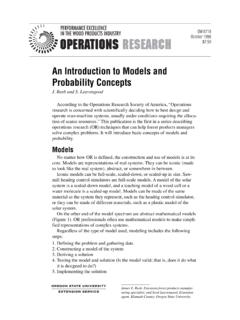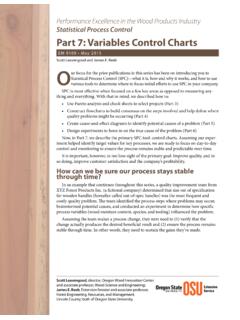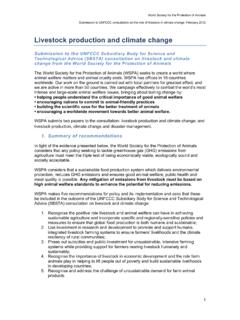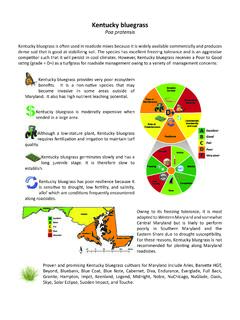Transcription of Applying Lime to Raise Soil pH for Crop Production ...
1 1 Soil acidification, or a decrease in soil pH, is a natural process that is accelerated by crop Production practices, primarily the use of nitrogen (N) fertilizers such as urea, ammonium sul-fate, or other fertilizers containing soil acidification occurs, soil chemical and biological properties change. One chemical change is increased solubility of aluminum (Al) and man-ganese (Mn), both of which can be toxic to plants. Plants vary in their tolerance of Al and Mn, creating crop-specific soil pH requirements. Adding lime (Figure 1) increases soil pH (reduces acidity), adds calcium (Ca) and/or magnesium (Mg), and reduces the solubility of Al and Mn in the soil. Soil pH managementThe first step is to determine the soil pH required for your crop. The pH at which yield is diminished varies among crops. Table 1 provides minimum soil pH recommendations for western Oregon crops. Crop-specific guidance is provided in Oregon State University (OSU) and Pacific Northwest (PNW) Extension nutrient management guides.
2 Other pub-lications in this series (Soil Acidity in Oregon and Table 1. Minimum soil pH values recommended for crops grown in western and , rhododendrons, and or small Grain or Sweet and seed legumes Crimson/subterranean clovers, Red clover for forage or White clover for forage or , seed, and turf , ornamental, fruit, and nut treesb, , brassica (broccoli, etc.) , assorted for small soil pH is below the minimum value, crop yields may be is given, as specific minimum pH values vary among crop pH for red maple should not exceed this value when a small area with a variety of vegetables is produced, especially when growing garlic, onions, spinach, radish, brassicas, and greens such as lettuce and P. Anderson, field crops Extension agent; John M. Hart, Extension soil scientist emeritus; Dan M. Sullivan, Extension soil scientist; Neil W. Christensen, professor of soil science emeritus; Donald A.)
3 Horneck, Extension agronomist; and Gene J. Pirelli, regional Extension livestock and forage specialist; all of Oregon State University. Anderson, Hart, Sullivan, Christensen, Horneck, and PirelliEM 9057 May 2013 Applying Lime to Raise Soil pH for Crop Production (Western Oregon)Figure 1. Lime application in Marion County, OR, about 1960. continues on page 3 OSU Marion County Extension office archives2 Publication summaryThis publication describes how to estimate lime application rate and lists criteria for choos-ing liming materials (source), lime application method (placement), and how often to apply lime (frequency). Lime application rate is determined using the lime requirement test (SMP buffer method). For established perennial or no-till crops, a top-dress lime application (1 to 2 t/a) may be benefi-cial. When very different soils are present within a field, variable-rate lime application is usually materials vary in effectiveness. The carbonate in traditional aglime (calcium or mag-nesium carbonate) reacts with soil acidity to neutralize it.
4 Liming materials have very limited move-ment into the soil without incorporation. Tillage increases effectiveness of all lime materials by mixing them into the rooting liming materials based on effective-ness (lime score) and cost. Calculate product cost per ton of 100-score lime products can be a cost-effective substitute for traditional aglime. Their characteristics should be evaluated carefully. For certified organic crops, use only lime approved by your certification application method (placement) takes two forms. Lime is either applied and left on the soil surface or incorporated. In the absence of till-age, soil pH increases only in the top inch or 2 of soil since lime s limited solubility means that the liming material must contact acidic soil before it will react and change soil of lime application is determined primarily by cation exchange capacity (CEC) and crop management practices, especially N fertil-izer rate. Soil pH declines faster in sandy (low CEC) soils than in soil with moderate to high clay content.
5 The typical rate of pH decline is approximately pH unit per year when 100 lb ammonium N/a is applied. For annual crop rotations, apply lime about a year before planting the crop that is most sensitive to soil acidity. For perennial crops, soil test and apply lime prior to tillage for crop establishment. Related publicationsThis publication is the first in a three-part series. We recom-mend you use them in combination. Soil Acidity in Oregon, EM 9061 (in press) Discusses why soil pH management is critical to long-term soil productivity. Explains the mechanisms whereby acidity injures crops. Gives historical perspective of what is known about soil acidity problems in Oregon soils and crops. Explains how to use soil and plant tissue testing to diagnose soil acidity Oregon Liming Guide, EM 9060 Provides recommendations for lime application for dryland and irrigated cropping systems in eastern 2. Lime application in Marion County, OR, 2012. Although application equipment has changed over the decades, techniques have not, and liming remains an important tool for maintaining crop Gingrich3 Eastern Oregon Liming Guide) also provide target soil pH values for many Oregon crops.
6 Next, use soil testing to monitor soil pH and determine whether lime application is needed to achieve your target pH. Collect soil samples at the same time each year to minimize seasonal variation. For annual crops established with tillage, moni-tor soil pH in the 0- to 6-inch or 0- to 8-inch depth (also the recommended depth for other routine soil analyses).In annual crops established without tillage, and in perennial crops, soil acidity usually is greatest (pH is lowest) near the soil surface. Therefore, a separate soil sample taken from the 0- to 2-inch depth can help in estimating lime need. See OSU Extension publication EM 9014, Evaluating Soil Nutrients and pH by Depth in Situations of Limited or No Tillage in Western Oregon, for soil sampling recommendations for perennial or no-till cropping soil pH with limeSoil acidification is reversed by adding a liming material. Liming materials are oxides, hydroxides, carbonates, and silicates of Ca and/or Mg. The anion in liming materials (chemically speaking, a base ) reacts with soil acidity (H) to neutralize it (Figure 3).
7 The most common liming material, aglime, sup-plies carbonate as the alone does not increase soil pH. For example, gypsum (calcium sulfate) and other addi-tives contain Ca but do not contain a basic anion (carbonate, hydroxide, oxide, or silicate). Therefore, they do not neutralize soil acidity. Terms used in this publicationIon a molecule in which the total number of electrons is not equal to the total number of protons, giving it a net charge Cation a positively charged ionAnion a negatively charged ionN nitrogen Ammoniacal N NH4+-NAl aluminum Mn manganeseCa calcium H hydrogenMg magnesium K potassiumThe cations, Al+3, Mn+2, Ca+2, Mg+2, H+, and K+ are used in this publication without charge desig-nations except when used in chemical cation exchange capacity, the sum of cations electrostatically attracted to 100 grams of soil expressed in milliequiva-lents (meq)Equivalent amount of a substance that will react with 1 gram of hydrogenMilliequivalent (meq) 1 1,000 of an equivalentCCE calcium carbonate equivalentBuffer material that is resistant to pH changeSlaked lime calcium oxide that has been mixed with water, creating calcium hydroxidePrilled or pelleted lime finely ground agri-cultural lime that has been mixed into a slurry with a water-soluble binding agent and pelletizedFigure 3.
8 Soil acidity reacts with lime to form water and carbon dioxide. The carbon dioxide gas is lost to the atmosphere. This chemical reaction continues until all of the lime has reacted. Figure by Dan decisionsManagement decisions related to liming can be grouped into four categories: Lime application rate how much lime is needed to neutralize soil acidity? Liming materials what source of liming material should be used? Application method how should lime be applied? Frequency of application how often should lime be applied?These decisions are discussed separately in this publication, but keep in mind that they often are application rateThe amount of lime needed is estimated by a lime requirement test using the SMP buffer (see infor-mation below). Other lime requirement tests are offered by soil testing laboratories, but only the SMP test results have been validated by OSU Extension research for use with lime recommendation tables and figures in this with most soil tests, the value reported using the SMP buffer is only an index; it means nothing by itself.
9 To interpret the SMP test for lime requirement, use either Figure 5 or Table 3 (page 6). Figure 5 and Table 3 are appropriate for only a limited range of target soil pH values. Consult crop-specific OSU Extension guides for additional lime rate information. SMP buffer testWhy the name?The SMP buffer test is named after Shoemaker, McLean, and Pratt, the soil scientists who pub-lished the method in 1961. UseLime reacts with H; therefore, the amount of both soluble and exchangeable H must be mea-sured or estimated to determine lime rate. When soil is mixed with water to measure soil pH in a laboratory, very little H is in soil solution. Most of the H is exchangeable, or electrostatically attracted to the soil particles. The SMP buffer measures H attracted to the soil particles as well as the soluble about the SMP buffer and western Oregon soil formed from volcanic ash, such as the Sifton series, is found in Appendix C (page 20).AccuracyThe accuracy of lime requirements estimated by the SMP test was assessed with incubation studies of western Oregon soils.
10 The correlation between lime requirement measured by SMP and lime requirement found by adding lime to soil was acceptable. Because the SMP test is not perfect, and because soil sampling techniques add variability, we recommend that you use SMP as a guide for lime requirement. Measuring soil pH after lime application verifies the adequacy of the lime application rate. Lime to apply recommen-dations given in Figure 5 and Table 3 (page 6) are usually accurate to ton of the SMPS ince some of the chemicals used to make the SMP test are hazardous (chromium and para-nitrophenol), substitute lime requirement tests have been developed. One method, the Sikora Buffer, has recently been developed by Frank Sikora at the University of test data using the Sikora Buffer have been evaluated via the North American Proficiency Testing (NAPT) program for several years. In NAPT evaluations to date, lime requirement determined by Sikora and SMP buffer tests have approximately a 1:1 correlation.













